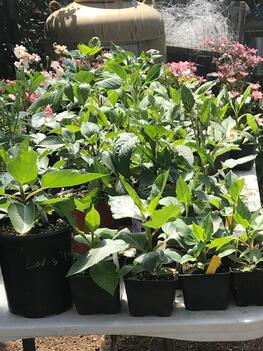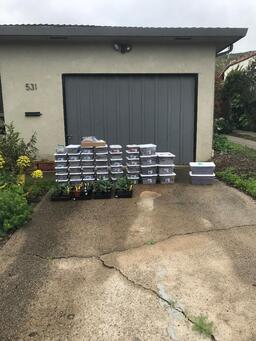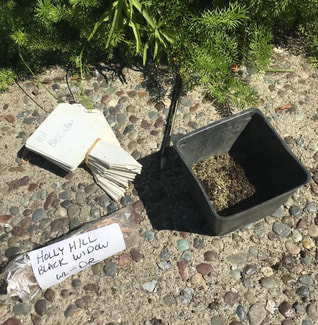|
As our dahlias grow they can become invaded with pests. What should one do? Most gardeners prefer to try more organic methods. Slugs, snails, and earwigs can munch away a plant in just one night. For these critters I use Sluggo Plus. It is safe for your pets and my chickens actually like to eat it. I sprinkle at the base of the plant and also place some of the pellets up high in the canopy and in the branch "crooks"of the dahlia. Another pest I have trouble with in the early stages in my garden are leaf miners. A leaf miner is any number of insects (moths, sawflies, beetles, and different flying insects) that lay eggs on the leaf of your plant and then the larvae chew tunnels through the leaves. Heavy infestations can weaken the plant. For this problem I use Monterey Horticulture Oil. It is a product that helps control a number of problems with dahlias. I try to incorporate a regular spraying routine of my dahlias throughout the growing season. About a 1/4 cup per gallon of the Horticulture Oil, applied with a sprayer, every 7 to 10 days. I recommend applying with a sprayer at dusk, after the bees and other beneficial pollinators have gone to bed for the day.
1 Comment
The photos above are from member Cory Kelso. On the left is a healthy cutting and on the right is a cutting Cory received from a dahlia seller. Cory noticed right away that the cutting was not doing well. As you can see, the leaves are mottled, and wrinkled. The dahlia is slow to grow and somewhat stunted. This dahlia should be thrown away. Do not compost, so that dahlia Virus does not transmit to other plants. Be sure to observe your plants during the first few weeks of growth. If you suspect virus, pull the plant and dispose of it, as it can be spread to other plants via inoculation of the plant sap from insects; such as aphids, white flies, and other pests. Viru can also be transmitted from plant to plant via a gardeners cutting, disbudding, and grooming of their plants. It is important to maintain clean cutting tools while caring for our dahlias.
Here on the central coast, members have been planting for the last several weeks. The last week of March brought a lot of rain and planting was delayed for many of us. There is more than one way or technique to planting tubers. Some grow exclusively in pots, some people start in small one gallon containers to get the tubers going, and others place their tubers directly in the soil. I dig a about a 4 inch deep hole and add my amendments (secret sauce) to the soil. Every year, I experiment with different amendments with planting. This year I used a combination of vermicompost, balanced organic fertilizer, and some mycorrhizae. Based on my soil testing that I did in the winter, I have plenty of Phosphorus, and I am not planning on adding this year. I lay the tuber in the amended hole, on its side, with the "eye" or sprout facing up towards the sky, and then I cover the tuber with about two inches of soil. I use plastic markers with the name of the variety written on it. Later, when I stake and tie off my dahlias, I will add another name tag up higher that is more visible and at my eye level on the dahlia. There are many techniques for marking your dahlias. Some people just like to put their dahlias in the ground, unmarked; enjoying the happy surprise that comes up. I prefer to keep track of my successes and failures: What grows tall or small? What is weak or strong? Is it a prolific bloomer or not? Is it late or early blooming? Marking helps me keep my dahlias more organized and helps me to plan for next year as well. Lastly, the soil should be moist, but not soggy. This April has given us some very warm days. Your soil should not be bone dry. Although we typically don't water until sprouts are above ground, we also should not let our soil completely dry out like the Sahara desert either. It's a bit of a juggle at first to find a good balance and losing a tuber or two, is not uncommon. I do hope that everyone is enjoying watching their dahlia spouts as they poke through the soil. Happy Planting Everyone!
Here is a photo of the rooted cuttings I made. They had a nice, warm, and comfortable stay in our dahlia society member, Cory's hoop house. They are very strong and healthy dahlia plants!
It took a tremendous amount of work, but our dahlia tuber sale moved to an online store format due to our county's COVID19 "shelter in place" orders. With the help and knowledge of our member, Laura Lucero, we were able to input all the tuber data and launch our site on 3/26/20. Member Cory Kelso came to my house and picked up all of my tubers and brought them to her house, where she organized a "warehouse" of dahlia tubers. Cory compiled and packaged all of the orders as they came in, and then her husband Jim, took the orders to the post office. It was quite a feat and I am so grateful that we were able to pull off this event. Despite the big success of the online format, I really must say that I missed having our tuber sale. The sense of community and fellowship of our fellow members was something that I missed very much this year. I also really missed seeing all the people in our community that would have come to our sale. Hopefully next year we can have our traditional sale and "shelter in place" will be a distant memory.
It is the first week of March and now dahlia growers start anticipating the coming growing season. Tuber orders are being delivered and we are assesing growing areas. Now is the time to start thinking about the layout of your dahlias. How much space do you have? Is your soil ready? Did you amend or grow a cover crop? Are you going to make any changes in watering or staking techniques this year?
There is an aspect to the planting season this year that I am going to give more consideration. That aspect is how tall and how wide does a particular variety grow? Tall growers should be grouped together. A tall growing dahlia, when placed next to a shorter growing dahlia could block a lot of sun. Tall growers also require more staking and tying off. It will certainly be easier to stake and tie larger varities together. If you are thinking of trying to hybridize this year, then you should also consider grouping your dahlias together by variety. For myself this year, I will be experimenting with hybridizing water lilly forms and incurved cactus forms. I will be planting these forms near each other in my dahlia garden, in an attempt to gather seeds for the following growing season!   These cuttings have been taken from the cutting bed and placed under lights with a plastic dome. It takes about 10 days for a cutting to start forming roots.  At the bottom of this plug you will see small white roots pushing through. It is now time to plant in a larger pot and continue with lights and heat.  The cutting is now planted and will stay under the lights with a heat mat as it continues to grow and form stronger roots. In another week or so, this cutting will go to the hoop house. Creating a cutting bed and taking cuttings of some of my dahlias has been a fun project this Winter. I am hoping that I will have several varieties that I will share with club members and sell at our tuber and plant sale on March 29th.
Many Thanks to all the members of the Central Coast Dahlia Society meeting this last Tuesday evening. A big thank you to our gracious host Barbara Bullock, for offering her home to us. We had about twenty members in attendance; not bad for a dark and cold January evening! Another thank you to member Carol Moore for supplying us all with reusable nametags, they are a nice touch and very helpful. The highlight of the evening was a presentation and talk on taking dahlia cuttings by Cory Kelso. We hope to continue the conversation and demonstration at next months meeting with actual real sprouted tubers and dahlia cuttings. I hope some of our members will consider attending the Pacific Southwest Dahlia Conference on Saturday February, 22nd at the Los Gatos Lodge. It is an excellent opportunity to meet dahlia growers from all over our state. There will be several lectures, presentations, and discussions about dahlia growing, showing, and hybridization. Following the discussion is a reception, banquet, awards ceremony, and excellent raffle.
The first day of 2020. I spent the good part of December digging, dividing and storing my dahlias. It was a cold, wet, muddy, and time consuming process. I really should have started in November, but time just got away from me this Fall. Most growers in the North part of San Luis Obispo county must get their dahlias stored either in clumps or as divided tubers due to much colder temperatures than the central and southern part of our county. I could have left mine in the ground, but there are a number of advantages to digging and dividing tubers. Removing my tubers from the beds gave me an opportunity to plant a green manure crop and add a significant amount of compost and composted chicken manure to my dahlia beds. It is my hope that my dahlias will require very little fertilizing during the growing season with all of the work I have put into the growing spaces this winter. Dividing my dahlias benefits our dahlia society as well. The majority of my tubers should make it through Winter storage and will be sold this spring at our tuber sale. Our first meeting of 2020 will be held at member Barbara Bullocks home. Cory Kelso will be demonstrating how to set up pot roots and how to take dahlia cuttings at this meeting. Cory will also host a dahlia dig and divide in the coming weeks at her home. We will be counting on volunteers to come and lend a hand for the dig and divide event. Hopefully members have their tuber orders in for the coming growing season and they are looking forward to, and reflecting on ways to improve their success in the garden for 2020. Happy New Year Everyone!
Heather J.  Fall is here and with zero rain so far and very hot days and cool nights. Evening temperatures have been in the 40's and daytime temps have been in the 80's. Hot, dry Santa Ana wind events have been routine this Fall. These conditions have made be reluctant to start digging and storing my dahlias for the Winter. However, next month will be our first Central Coast Dahlia Society Dig and Divide. I am hosting in my home from 9 to 2, an informational work day for people who want to learn more about digging and dividing up their dahlias. I am lucky to live in a climate here on the Central Coast that doesn't require me to dig and divide; I could certainly keep my tubers in the ground if I chose to. There are plusses and minuses to keeping my tubers in the ground, but this year the main reason for digging and dividing is my intention to amend my soil and plant a cover or "green manure crop". This cannot be done with the tubers in the ground, so away they go for the Winter! Please feel free to join me December 7th/8th from 9 to 2 to learn more if you wish. The Central Coast Dahlia Society will have more opportunities to learn how to dig and divide in late winter and early spring, when member Cory Kelso will need help in her dahlia patch. In other news, we had a fantastic meeting last Tuesday night at member Barbara Bullocks home. Topics of discussion included favorite places to buy tubers, digging, dividing, and storage options for your tubers, as well as the pros and cons of leaving them in the ground until Spring. Several members signed up to become members for 2020, many thanks to those of you that did sign up for another year last week! |
Archives
May 2020
Categories |









 RSS Feed
RSS Feed